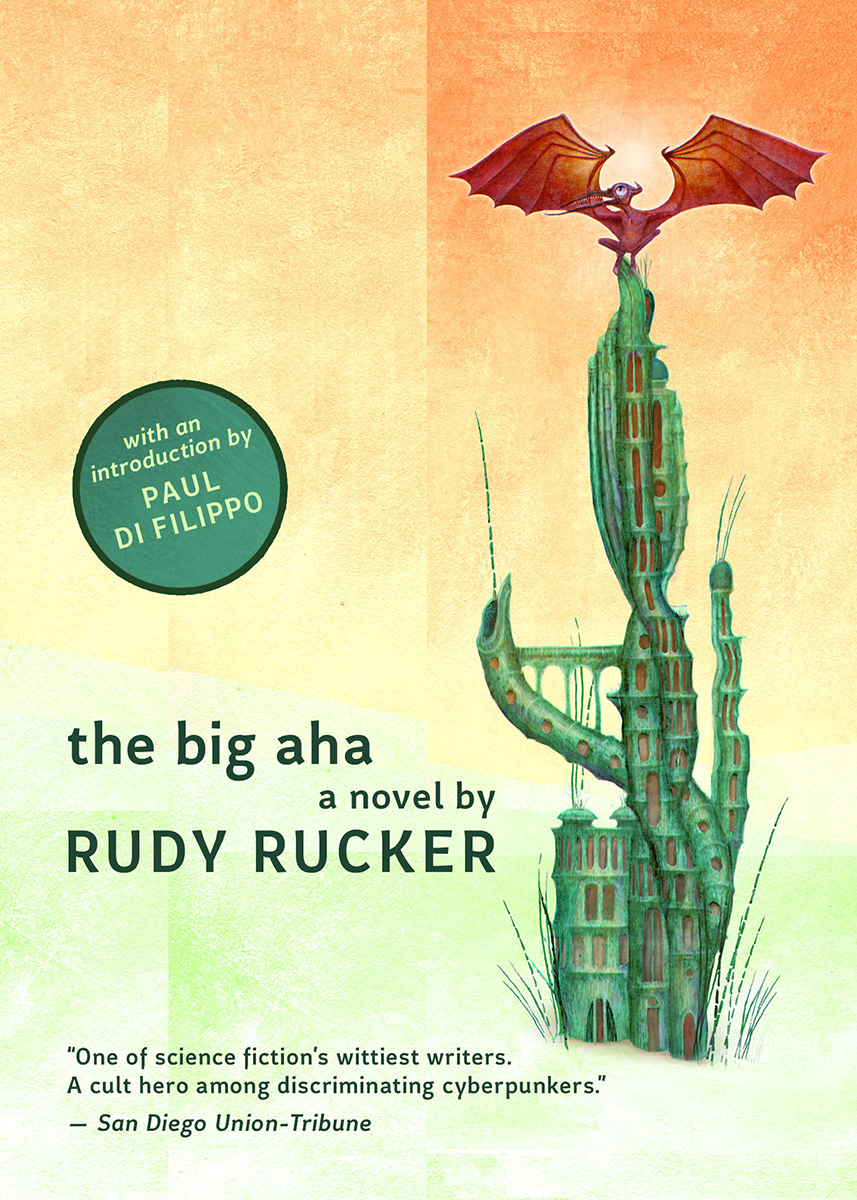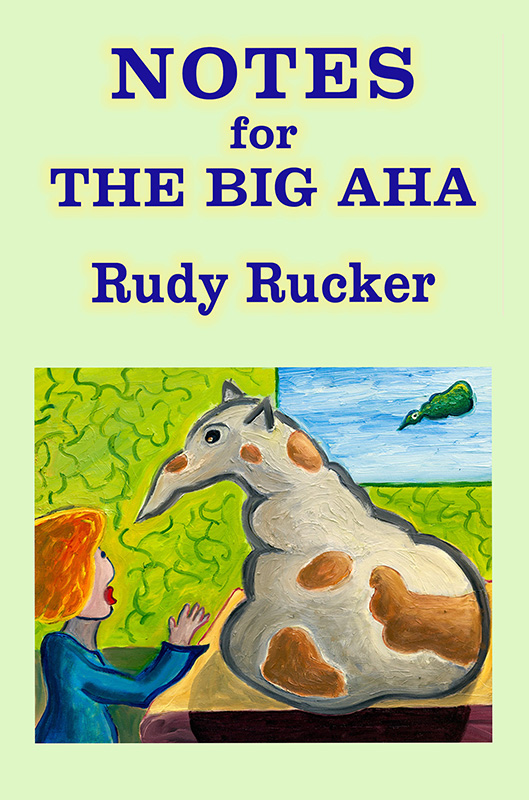|
The Big Aha, by Rudy Rucker
The Big AhaPaperback: Night Shade Books, July 2019, 2nd Edtion, with an introduction by Paul di Filippo. Order the paperback on Amazon or Barnes & Noble. See Rucker's other nine Night Shade books. SummaryBiotech has replaced machines. Qrude artist Zad Plant works with living paint. Career’s on the skids, wife Jane threw him out. Enter qwet—it’s quantum wetware! Qwet makes you high and gives you telepathy. A loofy psychedelic revolution begins. Oh-oh! Mouths in midair, eating people! Zad and Jane travel through a wormhole. And meet the aliens. Stranger than you ever imagined. What is the Big Aha? Reviews of The Big Aha"Rudy Rucker's latest novel, The Big Aha, is pure transreal Ruckeriana featuring extreme biological and quantum technologies, steamy techno-sex, nasty aliens from higher dimensions — and all soaked in the unique atmosphere of the magical 1960s. … This is a great example of how science fiction publishing is being redefined." The Bg Aha gloriously and objectively exists on an absolute level with all of Rucker’s classic work, chockfull of crazy yet scientifically rigorous ideas embodied in gonzo characters and plots. Like a jazzman, Rucker takes his intellectual obsessions as chords and juggles them into fascinating new patterns each time out…a rollercoaster ride that is never predictable and always entertaining…straight out of some Kerouac or Kesey novel, yet with a twenty-first century affect. Rucker is remarkably attuned to a new generation. Ultimately, all the craziness and whimsy and otherworldly menaces of Zad’s mad odyssey induces true pathos and catharsis in the reader. — Paul Di Filippo, Locus Online. Some passages have an oddly beautiful weirdness, tinged with old memories, like a humid summer day... Splendid flights of the imagination. Rucker has been writing like a mind-meld of Gödel and Burroughs on acid, but with some sort of academic overmind trying, and for the most part succeeding, to run the result through a logical scientific-refereed-paper process... But there is something else to this novel, a characterological sweetness combined with a political passion the nature of which might cause Rucker to deny that it is political... What Rudy Rucker presents and champions is the last and finally successful battle in the culture war dating back to the Transcendental Movement of the nineteenth century that peaked in the 1960s. — Norman Spinrad, Isaac Asimov's SF Magazine. From the AuthorRegarding the origins of The Big Aha, one of my basic inspirations was that I’ve always felt like the psychedelic revolution of the late Sixties and early Seventies didn’t last long enough. I wanted to revive that time’s spirit in the context of an SF novel set in the not too distant future. My stylistic model was William J. Craddock’s little-known novel of the Sixties, Be Not Content. The book features deeply funny interactions among the early acidheads of the San Francisco Bay area. I first read it in 1972, shortly after its initial publication. For years I chuckled fondly to myself about Craddock’s masterpiece. But by 2012 the book was all but unfindable. I took it upon myself to republish it—to clean off the master’s grave, you might say—and thus my publishing enterprise Transreal Books was born with an edition of Be Not Content. In writing The Big Aha, I wanted to reproduce Craddock’s spaced-out, off-kilter, irresponsible glee. But, these being postmodern times, I didn’t want to do it in terms of drugs. Drugs have been done to death. So I turned to quantum mechanics. My Boulder Creek friend Nick Herbert was the one who initially hipped me to the psychedelic potential of quantum mechanics. I’ve known Nick since moving to California in 1986. As well as being a freaky, giggling mountain hermit, old Nick is a genuine physicist with degrees, a dusty job resume, and excellent popular-science books to his credit, including his 1985 magnum opus, Quantum Reality. Nick has a lifelong dream of finding direct ways to experience the paradoxical nature of quantum reality. Nick terms this a quest for quantum tantra. He suggests that one step along this path might be to look into your own mind and to notice that quantum and classical processes are both at work. I ran with this idea, and my Big Aha characters talk about being in the cosmic versus the robotic mode. In order to make my novel be more of a thrilling wonder tale, I beefed up quantum tantra by tacking on a second SFictional trope, that is, wetware. And thus I arrived at qwet, or quantum wetware, which also gives people telepathy, which is another long-term interest of mine. I put a kink into my qwet teep by hewing to Nick Herbert’s scientific dictum that, logically speaking, people must forget whatever they learn via telepathy. Otherwise they might be exchanging information faster than light! Oblivious teep is a nice metaphor for intimate human communication. “Yes we made love, but I don’t remember a word we said.” A transreal aspect of the book is that I set it in Louisville, Kentucky. I grew up there, and I wanted to reminisce a little about my youth, and about my parents, who inspired my main character's parents. MoreRucker's Big Aha art show at Borderlands in SF. Rucker discusses The Big Aha in a May, 2013, Locus interview. As well as documenting two years of writing a novel, Notes for The Big Aha describes the author’s transition to new modes of publishing. Amusing, inspiring, and worldly wise, these writing notes may prove useful and encouraging for your own creative work, not to mention enhancing your appreciation of The Big Aha itself.
Notes for the Big Aha |

